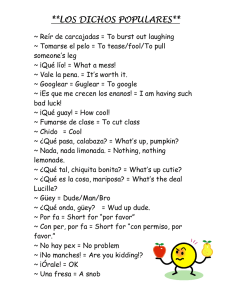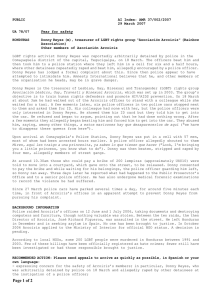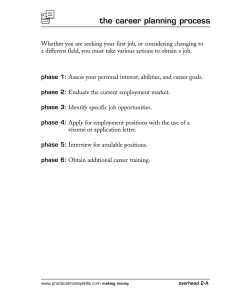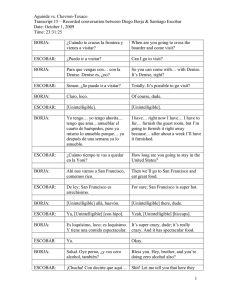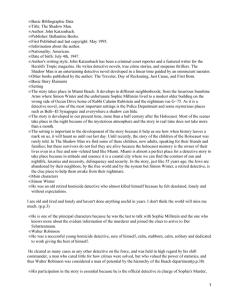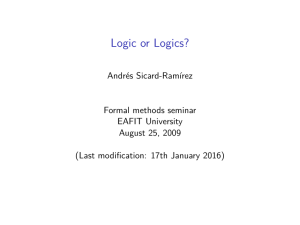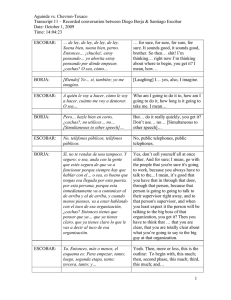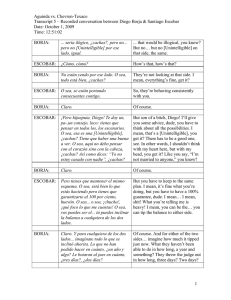“New Shit Has Come to Light” - Information Seeking Behavior in The Big Lebowski
Anuncio
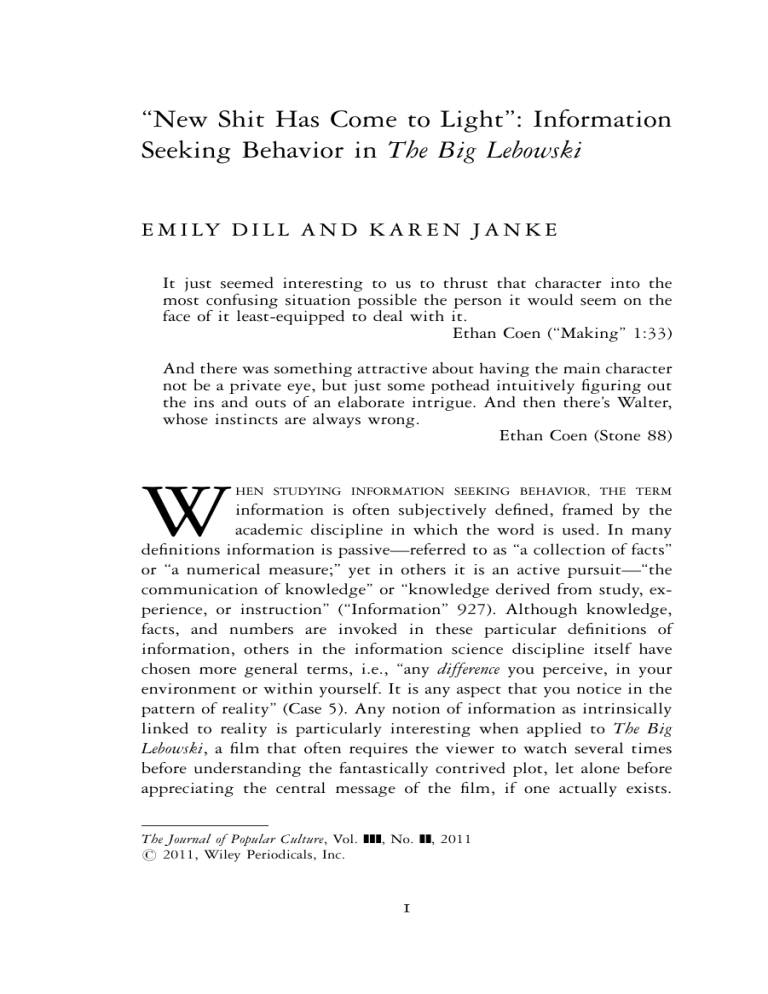
‘‘New Shit Has Come to Light’’: Information Seeking Behavior in The Big Lebowski E M I LY D I L L A N D K A R E N J A N K E It just seemed interesting to us to thrust that character into the most confusing situation possible the person it would seem on the face of it least-equipped to deal with it. Ethan Coen (‘‘Making’’ 1:33) And there was something attractive about having the main character not be a private eye, but just some pothead intuitively figuring out the ins and outs of an elaborate intrigue. And then there’s Walter, whose instincts are always wrong. Ethan Coen (Stone 88) W HEN STUDYING INFORMATION SEEKING BEHAVIOR, THE TERM information is often subjectively defined, framed by the academic discipline in which the word is used. In many definitions information is passive—referred to as ‘‘a collection of facts’’ or ‘‘a numerical measure;’’ yet in others it is an active pursuit—‘‘the communication of knowledge’’ or ‘‘knowledge derived from study, experience, or instruction’’ (‘‘Information’’ 927). Although knowledge, facts, and numbers are invoked in these particular definitions of information, others in the information science discipline itself have chosen more general terms, i.e., ‘‘any difference you perceive, in your environment or within yourself. It is any aspect that you notice in the pattern of reality’’ (Case 5). Any notion of information as intrinsically linked to reality is particularly interesting when applied to The Big Lebowski, a film that often requires the viewer to watch several times before understanding the fantastically contrived plot, let alone before appreciating the central message of the film, if one actually exists. The Journal of Popular Culture, Vol. ]]], No. ]], 2011 r 2011, Wiley Periodicals, Inc. 1 2 Emily Dill and Karen Janke Despite this tenuous connection to reality, it is knowledge and facts, the very basis of information according to some, which play a central role in the film, not to mention the quintessential debate in which many Achievers (Lebowski fans) participate: ‘‘Where’s the money, Lebowski?’’ (Big Lebowski 3:57). Whether intentional by the writer/director Coen brothers or not, The Big Lebowski reveals how subjective the terms ‘‘information’’ and ‘‘facts’’ truly are in the twenty-first century; a world of nonstop news and ubiquitous talking heads. What is truth to one person is not necessarily truth to another—what is merely a ringer briefcase full of ‘‘whites’’ to one person can be a US$1,000,000 epiphany to the next. The film’s most important contribution to the study of information seeking behavior is its illustration of how a highly complex information search is not about finding the ‘‘answer,’’ but rather is about an individual’s ability to make sense of and create meaning from the process of information seeking (Dervin par. 8). The answer may be that Bunny Lebowksi was not kidnapped after all, but what is the meaning for The Dude? That he solved the case? That he never got his rug back? The methods employed when a person seeks information and incorporates it into her existing knowledge base often determine how well she will grow in her understanding of a specific information need, or more broadly, in life itself. Put another way, the self-defined process of seeking meaning is the very basis of the human condition, and one that is a central fixture in The Big Lebowski. As Ethan Coen related, watching a seemingly inept person struggle with a complex situation was ‘‘the conceit’’ of the film (‘‘Making’’ 1:47). This paper analyzes the information seeking behaviors of Donny Kerabatsos, Walter Sobchak, The Dude, and Maude Lebowski through the lenses of a variety of information seeking theories and models. This analysis of The Big Lebowski illustrates the concept of sense-making as a richer, more contextualized process than simply collecting facts. Even though the situations the characters encounter may be artificially constructed for the purposes of advancing the plot of the film, the steps that The Dude, Maude, Donny, and Walter take or fail to take in attempting to close their knowledge gaps mirror the way ‘‘real people’’ act. Situated on the cusp of the revolution brought on by rapid expansion of the Internet’s reach into daily lives, these characters offer prime examples of the selfdefining quality of information searches and how truth really is in the eye of the searcher. Each character employs different information seek- ‘‘New Shit Has Come to Light’’ 3 ing strategies and meets with varying levels of success. We will begin with the least successful and progress to the most successful information seeker. A look at the characters: ‘‘Yeah, well, you know, that’s just like, uh your opinion, man . . .’’ (Big Lebowski 0:28:50) Donny: ‘‘What’s a pederast?’’ (Big Lebowski 0:26:56) Studying Donny provides a glimpse into the information landscape that builds the reality of those with low-level information seeking skills. Donny’s information seeking behaviors do not receive large amounts of screen time, but the ones on display typically include asking others what they are talking about or what their point is. Through these monotonous and usually unsuccessful queries, we are able to describe some of the stumbling blocks that keep Donny from building a more robust world-view. One problem Donny faces time and again is his use of inappropriate information sources. Though Walter and The Dude might be convenient sources, they are not necessarily the most authoritative on many subjects. Selection of dubious information sources is an information seeking behavior typical of working class individuals. Elfreda Chatman pioneered the use of ethnographic methods to research the information behaviors of groups of people not typically studied: working poor, women, prisoners, and retirees. When examining the information seeking behaviors of female janitors, she observed that members of this population ‘‘were not active seekers of information outside of their most familiar social milieu’’ (438). Chatman’s research reveals that for a variety of reasons, members of these social groups have little motivation to investigate the accuracy and appropriateness of their chosen information sources, and are most interested in ‘‘those things that were accessible, had a firm footing in everyday reality, and responded to some immediate, practical concern’’ (438). While the use of bowling teammates as information sources is not always a poor strategy, it cannot be the only strategy employed to successfully fill every information need. Williamson’s research into information seeking among older adults confirms that most people prefer 4 Emily Dill and Karen Janke informal sources for spur of the moment information needs, while formal sources are consulted as part of a plan (24). Donny fits into this paradigm as well—he does not have any hierarchical information goals so he sticks with sources that most people use for their spur of the moment needs, for better or for worse. In addition to not being the most knowledgeable information sources, The Dude and Walter are not the most courteous or inclusive sources. The typical result of Donny’s frequent queries is that instead of being brought into the interactive fold of the conversation, he is rebuked for even trying to participate, as is evidenced in this exchange with Walter: Donny: What tied the room together, Dude? The Dude: My rug. Walter: Were you listening to The Dude’s story, Donny? Donny: What? Walter: Were you listening to The Dude’s story? Donny: I was bowling. Walter: So you have no frame of reference here, Donny. You’re like a child who wanders into the middle of a movie and wants to know— (Big Lebowski 0:07:53) Donny’s ignorance regarding his bowling partners’ conversational topics is reflective of Jones and colleagues’ research into information sharing within groups. These dismissive behaviors are an example of keeping someone ‘‘out-of-the-loop,’’ a situation defined as a ‘‘. . . specific form of ostracism . . . individuals are excluded only from information rather than from all of the group’s activities’’ ( Jones et al. 158). The result of this type of exclusion manifests itself by ‘‘lower levels of belonging, self-esteem, control, and meaningful existence’’ ( Jones et al. 169). Interactions like the one highlighted above lead the viewer to believe that perhaps the root of Donny’s poor information seeking behavior is not a lack of metacognitive ability, but rather a lack of selfconfidence. Just as information seeking itself is a recursive process, so is the reinforcement of poor self-image. Donny revisits the same information sources time and again but never breaks the cycle of being dismissed. In the few instances where Donny attempts to add his own knowledge to the conversation, he is rebuked and reminded of his failure to contribute anything meaningful. When The Dude mentions a quote by Lenin, Donny tries to join in the conversation by providing ‘‘New Shit Has Come to Light’’ 5 another quote by John Lennon. Walter responds in turn by chiding Donny: The Dude: It’s all a goddam fake, man. It’s like Lenin said, you look for the person who will benefit, and you will, uh, you know, you’ll, uh, you know what I’m trying to say— Donny: I am the walrus. Walter: That fucking bitch! The Dude: Yeah. Donny: I am the walrus. Walter: Shut the fuck up, Donny! V.I. Lenin. Vladimir Ilyich Ulyanov! (Big Lebowski 0:27:51) It is situations like this that serve to fortify Donny’s poor self-image and keep him from gaining the confidence needed to be more selfdirected. Kuhlthau points out that in a successful information search, ‘‘. . . an increase in confidence corresponds to an increase in clarity and focus in thoughts and may also correspond to evidence of construction or sensemaking’’ (365). Because Donny is consistently dismissed when he attempts to contribute his own experiences to the collective information search, he never achieves the confidence boost needed to progress in his personal information seeking behaviors. Case puts it another way in his review of J. D. Johnson’s information behavior model: Beliefs are important in information seeking because they constrain the individual’s thinking and level of motivation regarding information seeking. . . . Beliefs are not only about facts, but also about our relation to the current situation: our degree of control over events, our self-efficacy. If we do not believe that knowing more about a topic will allow us to affect a change, then we are not likely to seek information. (134) An example of how Johnson’s beliefs theory informs Donny’s behavior can be seen in Donny’s treatment of the kidnapping. Even though The Dude and Walter are constantly discussing the case, Donny does not take part in any decision-making or theorizing surrounding Bunny’s disappearance or the whereabouts of the ransom money. He does not feel that he has anything meaningful to contribute to the investigation. The only time he is present during the whole caper is when The Dude and Walter visit the Sellers home. Even then, Donny sits in the car and is ostensibly only along for the ride because they are Emily Dill and Karen Janke 6 also planning to stop at the In-N-Out Burger on Camrose. One piece of Donny’s reality that he is sure of is that ‘‘Those are good burgers, Walter’’ (Big Lebowski 1:07:49). Regardless of the underlying etiology, Donny fails to learn from his mistakes in the information search process, therefore condemning himself to ignorance. Because Donny never experiences any confidence boost from assimilating new knowledge into his extant knowledge base, he remains a constant, albeit ineffective, questioner. Walter: ‘‘Am I wrong?’’ (Big Lebowski 0:09:25) Walter’s information seeking style provides a stark contrast to Donny’s, and might best be described as hands-on. To his credit, Walter seems to formulate a goal-oriented plan with fixed steps along the way: Walter: So all we gotta do is get her back. No one’s in a position to complain. We keep the baksheesh. The Dude: Yeah, terrific, Walter. But you haven’t told me how we’re gonna get her back. Where is she? Walter: That’s the simple part, Dude. We make the handoff, I grab one of ’em and beat it out of him. (Big Lebowski 0:34:48) In spite of his calculations, Walter’s execution of his plans often includes an abundance of false assumptions (e.g., thinking Larry Sellers is a ‘‘dunce’’ who will succumb under his interrogation (Big Lebowski 1:08:22)) and missteps (e.g., smashing the neighbor’s Corvette thinking it was purchased by Larry Sellers with the ransom money (Big Lebowski 1:12:11)). These components of Walter’s information behavior are rooted in two theories related to the study of information seeking behavior: personal construct theory and competency theory. Both theories are useful in explaining some of Walter’s shortcomings as a searcher and in illustrating how his reality is constructed. George Kelly first described personal construct theory in 1963. In addition to Kelly’s native field of psychology, it has since been used by a variety of fields to describe how people relate to new information that enters their environment. Personal construct theory differentiates between indicative and invitational attitudes. The indicative attitude refers to a person who depends so heavily on the construct he ‘‘New Shit Has Come to Light’’ 7 currently holds that he automatically rejects any new information that conflicts with that construct (Kuhlthau 362). As Kelly describes it, the indicative personal construct can lead to a hampering of new information acquisition: When we know something, or think we do, we make up sentences about it, using verbs cast in the indicative mood. We talk about it in a way that appears to be objective. But science tends to make its progress by entertaining propositions which appear initially to be preposterous. (Kelly, ‘‘Clinical Psychology’’ 150) Walter’s self-assurance embodies the indicative attitude, perhaps most memorably illustrated in his vitriolic comment before the final confrontation between The Dude and The Big Lebowski: ‘‘Let me tell you something else. I’ve seen a lot of spinals, Dude, and this guy’s a fake. A fucking goldbricker. This guy fuckin’ walks. I’ve never been more certain of anything in my life’’ (Big Lebowski 1:38:38). In spite of the fact that the Big Lebowski is sitting in a wheelchair, Walter is so sure of his prejudgment that he proceeds to lift the man out of his chair to prove he can in fact walk and ends up dropping the paralyzed man on the floor. While it is expected that all people will rely to some degree on their currently held construct, those who exhibit an invitational attitude, in direct contrast to Walter, will evaluate conflicting information carefully and assimilate any conclusions into their knowledge base. Even though truth and information are certainly subjective in the construction of a personal reality, a refusal to evaluate the beliefs a person currently holds in light of new observations is a sign of counterproductive information seeking behavior. Whereas Donny is constantly, if ineffectively, asking questions, Walter will not entertain the idea that perhaps he is not the authority on everything. If one of Donny’s failures is poor self-esteem, then one of Walter’s is hubris. As a corollary to personal construct theory, Walter’s information search process also suffers from the strength to which he holds on to his preconceived notions. This adds to his inability to let in new information, especially when it comes to the beliefs he holds dearest, such as those dealing with bowling and Vietnam. When Walter sees his opponent, Smokey, cross the line while bowling he refuses to accept that he might have been wrong at least in part because 8 Emily Dill and Karen Janke it is a league game which will determine who moves into the next round robin and is therefore a high-stakes situation for Walter: Walter: OVER THE LINE! Smokey: Huh? Walter: I’m sorry, Smokey. You were over the line, that’s a foul. Smokey: Bullshit. Mark it 8, Dude. Walter: Uh, excuse me. Mark it zero. Next frame. Smokey: Bullshit, Walter. Mark it 8, Dude. Walter: Smokey, this is not ’Nam. This is bowling. There are rules. (Big Lebowski 0:17:30) As Brannon et al. showed in their 2007 study, overall people tend to prefer attitudinally consistent information but the preference was greatest among study participants who had strongly held attitudes (615). Walter holds strong attitudes about many things, therefore he is usually loathe to consider any information counter to his beliefs. In addition to the damage caused by his refusal to allow any divergent information to alter his opinions, Walter’s information search process also suffers in another way. Competency theory, put forth by Kruger and Dunning, tells us that ‘‘when people are incompetent in the strategies they adopt to achieve success and satisfaction, they suffer a dual burden: Not only do they reach erroneous conclusions and make unfortunate choices, but their incompetence robs them of the ability to realize it’’ (1121). In applying this theory to the information seeking behaviors of students, Gross follows, ‘‘Stated another way, overconfidence can be an indicator of incompetence’’ (156). Walter repeatedly dooms his searches to failure with quick assumptions and a lack of selfassessment. Walter’s inability to take stock of a bad choice and learn from it is best illustrated by his recap of the disastrous money hand-off. The Dude is worried about Bunny’s fate, but Walter’s response to being asked how it went glosses over his failures, ‘‘Went all right. Dude’s car got a little dinged up’’ (Big Lebowski 0:39:39). In summary, the reality Walter builds for himself through his information seeking is one in which he is never wrong. While Walter’s concept of the truth coincides with a user-created reality seen in Web 2.0 technologies, he is not apt to agree with the resulting democratization of knowledge, unless it only includes others who choose to agree with him. Walter circumvents the careful, deliberate steps involved in an effective information search process in favor of what in his ‘‘New Shit Has Come to Light’’ 9 knee-jerk mentality he already ‘‘knows’’ to be true. As Stephen Colbert, perhaps channeling Walter Sobchak, once said, ‘‘Who is Brittanica to tell me that George Washington had slaves? If I want to say he didn’t that’s my right’’ (‘‘Wikiality’’ 1:43). The Dude: ‘‘I could be just sitting at home with pee stains on my rug.’’ (Big Lebowski 0:57:48) The Dude’s information seeking behaviors, in contrast to Donny’s and Walter’s, are ultimately successful in bringing a certain measure of personal enlightenment. The Dude manages to avoid the pitfalls that make his teammates’ searches unsuccessful and is therefore left with a focused perspective of the problem at the film’s end. Although he is not a particularly proactive information seeker in most situations, The Dude’s invitational attitude allows him to keep his mind open to ‘‘new shit’’ (Big Lebowski 50:11). He is receptive to information from a variety of sources, employing a more sophisticated information seeking strategy than his friends. This openness is very important to his success as an information seeker and stands as a direct contrast to Walter’s indicative attitude. The Dude doubts that Bunny really kidnapped herself, yet he remains receptive to additional information. When The Dude receives the severed toe, purportedly taken from Bunny’s foot, he considers this possible evidence that the kidnapping is real and keeps his mind open to any possibilities that would help save Bunny’s life. Conversely, Walter chooses to focus on how the toe evidence could be falsified, rebutting ‘‘I can get you a toe, believe me. There are ways, Dude. You don’t wanna know about it, believe me’’ (Big Lebowski 53:11), rather than entertaining the possibility that his beliefs about the kidnapping are wrong. Like Donny, The Dude often relies on information sources from his own social milieu, but he is not averse to information that comes from just about anyone or anywhere. An example of this is when Maude shows The Dude the Bunny Lebowski porn vehicle Logjammin’ (Big Lebowski 45:33). After viewing the film, the Dude is able to connect Bunny to Jackie Treehorn and Karl Hungus/Uli Kunkel, information he later uses in confrontations with The Big Lebowski, Jackie Treehorn, and the Nihilists. Though it is more convenient to build his worldview solely based on what he learns from Walter and Donny, The Dude instead incorporates information from sources as diverse as a 10 Emily Dill and Karen Janke pornographic film and an encounter with Da Fino, the private detective, to create a more nuanced view of the situation. The Dude also exemplifies how a positive attitude can benefit an information search. For the most part, The Dude weathers the ups and downs of his quest with an optimistic attitude, though he does at times succumb briefly to the lows associated with the emotional rollercoaster typical of even successful search processes (e.g., an initial feeling of confidence in the theory that Bunny kidnapped herself is thrown into doubt when the money handoff goes poorly) (Kuhlthau 366 – 68). His generally pleasant demeanor is evidenced in his conversation with the limousine driver. Even though his car was just stolen (with the supposed ransom money inside), The Dude chooses to focus on the positive: The Dude: I gotta tell you, Tone, man. Earlier today I was really feeling shitty, man. Really down in the dumps. Lost a little money— Tony: Hey, you know what? Forget about it, huh? Forget about it. Dude: Yeah, fuck it, man. You can’t be worried about that shit. Life goes on, man. (Big Lebowski 48:37) Such positivity is a key component of The Dude’s successful information search, confirming the results of research by Jonas et al. on cognitive dissonance and mood regulation in information seeking. This study found that ‘‘. . . being in a negative mood makes a critical examination of the available evidence especially difficult because dissonant information is experienced as more annoying compared to being in a positive mood’’ (13). When in a good mood, The Dude overcomes the cognitive dissonance that occurs when he is confronted with twists and turns in the case and ultimately accepts divergent information into his knowledge base. The prime example of his positive attitude contributing to a successful information search comes in the post-coital scene with Maude when all of the case’s loose ends come together in The Dude’s mind. At this critical juncture, The Dude begins to piece together the convoluted story and the viewer can almost see the gears turning in his brain, illustrating the deepening cognitive levels encountered in an information search: The Dude: So . . . that doctor, uh. Maude: Exactly. Now what happened to your face? Did Jackie Treehorn do that as well? ‘‘New Shit Has Come to Light’’ 11 The Dude is staring off into space, thinking. His answer is absent. The Dude: No, uhhh, It was the Chief of police of Malibu. A real reactionary . . . So your father . . . Oh yeah, I get it! Yeah, Yeah! Maude: What? The Dude: Oh man, my thinking about this case had become very uptight. Yeah. Your father— (Big Lebowski 1:31:00) The mood-enriching experience of coitus has seemingly brought him to the conclusion that there was never any money and that the entire kidnapping was a scheme perpetrated by the Big Lebowski to augment his own personal wealth. If an information search were a static process, it would stand to reason that The Dude’s motivation would still be to have an unmicturated -upon rug in his apartment. In fact, after solving the case, The Dude only wants to confront The Big Lebowski, the man who once chided him that, ‘‘The bums will always lose’’ (Big Lebowski 14:47), perhaps in an effort to publicize his successful information search. The end of The Dude’s search process brings a focused perspective of the problem, and creates meaning (realization that the whole thing was rigged) as opposed to answers to specific problems (who were the Nihilists anyway?, was Bunny involved in the fake kidnapping?, what exactly happened to the money?, etc.). He ultimately abandons any attempts to acquire the money he was promised by The Big Lebowski or Maude, and focuses on Donny’s ‘‘funeral’’ and the bowling tournament semifinals. The reality that The Dude builds for himself using his less than deliberate, yet seemingly effective, information seeking skills is one that is not as information-impoverished as Walter’s and Donny’s. The key elements of The Dude’s successes are the invitational personal construct he holds and the robust information mosaic that openness allows him to build, paired with his ability to keep anxiety at bay and remain positive. What is not clear is if his achievements result in part from the ‘‘strict drug regimen’’ (Big Lebowski 1:29:45) he uses to keep his mind limber, but the mention of it shows us that The Dude at least attempts to create an environment that fosters learning. In The Dude’s constantly evolving reality, he uses his skills effectively to bridge information gaps and build his own utopian world in a way that the Port Huron Statement failed to do for everyone else. Maude: My father’s weakness is vanity, hence the slut. (Big Lebowski 1:30:20) 12 Emily Dill and Karen Janke Of the main characters in The Big Lebowski, Maude exhibits the most successful information seeking behaviors. While a vaguely foreign accent and an affinity for Fluxus art might be enough to convince the viewer of Maude’s cognitive superiority, taking a closer look at her well-honed information seeking skills and how her personality contributes to these skills, while contrasting them with the skills of Donny, Walter, and The Dude sheds light on the reasons for her success. Unlike Donny and Walter, Maude has a healthy level of selfesteem—enough that she trusts herself to navigate the information landscape, but not so much that it inhibits her acceptance of new ideas. She recognizes her father’s weaknesses and distrusts him, but is willing to listen to The Dude’s theories on the case even when they conflict with her ideas. Her constant invitational attitude allows her to gather pertinent information whenever it presents itself and from whatever source it may come. As Kuhlthau describes the effects of an invitational attitude on the information search process, it allows the searcher to ‘‘assume a posture of expectancy and enables (him or) her to take risks and to profit from mistakes’’ (363). Aligning oneself with The Dude might seem risky to some, but Maude makes a calculated choice that pays dividends to her later in the film. Another reason for Maude’s success might be attributed to the ‘‘openness to experience’’ she exhibits; an extension of the invitational personal construct. Openness to experience is defined by Heinström as: . . . a measure of depth, breadth and variability in a person’s imagination and urge for experiences. The factor relates to intellect, openness to new ideas, cultural interests, educational aptitude and creativity as well as an interest in varied sensory and cognitive experiences. (par. 25) As a Fluxus artist whose work has been commended as being strongly vaginal, Maude makes clear her interest in creative expression and new experiences. In Heinström’s study, participants who exhibited openness to experience also tended to put more effort into an information search and sought out a wider variety of information sources than the more conservative participants. While The Dude and Maude both benefit from an invitational attitude, Maude outperforms The Dude by proactively seeking information to close her knowledge gaps. The Dude drifts from theory to ‘‘New Shit Has Come to Light’’ 13 theory and discovers information by chance along the way. By contrast, the thought processes behind Maude’s information seeking behaviors are easy to follow. Her success in the search process is easily measurable because of her use of goals that are clearly laid out for the viewer: to retrieve her mother’s rug, to get the Lebowski foundation money back without embarrassing her father and, as her statement in the following scene illustrates, to conceive a child with a partner with certain desirable characteristics, ‘‘Look, Jeffrey, I don’t want a partner. In fact, I don’t want the father to be someone I have to see socially or who will have any interest in raising the child himself’’ (Big Lebowski 1:30:50). Maude also shows her use of appropriate information sources when she sends The Dude to see a doctor under the false pretenses of checking the head wound her associates gave him. The real reason for the doctor visit is to surreptitiously assess The Dude’s physical health and ability to father a child before Maude decides to employ his spermdonation services. This is in direct contrast to Donny, who uses whoever is convenient, usually Walter. Although the viewer doesn’t necessarily know how she accomplishes her goals, they see the results of Maude’s off-screen activities. Her offscreen successes include her ability to obtain the tape of Logjammin’ and locating The Dude with a phone call to the bowling alley, though she has spent little time with him and their conversation never turned to bowling. She also uses complex cognitive skills to combine her past knowledge about the personal characteristics and marriage of The Big Lebowski and Bunny with new ideas from The Dude to come to the conclusion that the kidnapping of Bunny ‘‘stinks’’ (Big Lebowski 0:44:35). Maude’s exceptional information seeking behaviors ultimately allow her to avoid chasing the red herrings that plague the other characters throughout the caper. While viewers might still be trying to sort out The Big Lebowski’s cacophonous plot lines at the end of the film, it is doubtless that Maude’s information search goals were clearly met. Conclusion: ‘‘Yeah, well, The Dude abides.’’ (Big Lebowski 1:50:43) The Big Lebowski was released in 1998, at the dawn of the information explosion created by the ever-expanding influence of the Internet. In the early days of the Internet, a person often relied on a 14 Emily Dill and Karen Janke variety of information sources to satisfy a specific information need, and did so at her own initiation, often referred to as information pull. Now, it is much more frequent that a person has information pushed at him through a variety of online technologies that enable an individual to maintain constant awareness on selected topics with a minimal level of exertion, and to do so while easily filtering out undesirable viewpoints. The effects of this sea change in information behavior has been, and will continue to be, staggering: ‘‘As the proliferation of digital media accelerates, we are witnessing profound social, cultural, and political transformations whose long-term outcome we cannot begin to foresee’’ (Wright 6). The Dude appears to operate in neither an information pull, nor in an information push landscape, but rather in more of an information breadcrumb trail landscape—stooping to pick up pertinent information that happens to cross his path. This middle ground is arguably the most efficient method for creating personal meaning in the Internet age. Before Web 2.0 technologies such as blogging, RSS, wikis, and social networking became ubiquitous, the information landscape provided a more linear path from information creator to information consumer: there were those who made the news, those who reported on it, and those who consumed that reportage. Now, everyone can be an author or reporter, and the line between creator and consumer is as blurry as the distinction between fact and fiction. Facts can be debated, but the recent trend has been to equivocate by degrees of ‘‘truthiness’’ and to form a reality based on tacit consent. An example of this is the popular Internet encyclopedia Wikipedia, which has often come under fire because anyone can, and has, edited entries to contain misrepresentations at best, falsehoods at worst. Most memorably, on the July 31, 2006 episode of The Colbert Report, Stephen Colbert challenged his audience to bring ‘‘democracy to knowledge,’’ and edit the entry on African elephants to claim that the population of African elephants had tripled in the past six months (‘‘Wikiality’’ 3:50). Thousands flooded the site, causing it to crash and the Wikipedia administrators locked the entry on African elephants to prevent editing by new or anonymous users (Ahrens). In a later episode, Colbert again professed to champion the site where ‘‘You can be an authority even if you don’t know what the hell you’re talking about’’ (‘‘Wikilobbying’’ 0:11). This is an extreme example of a reality as created by the collective, or as Colbert says ‘‘together, we could create a reality that we can all agree on; the ‘‘New Shit Has Come to Light’’ 15 reality we just agreed on’’ (‘‘Wikiality’’ 4:04). So while the methods of information retrieval may have changed greatly in the intervening years, The Big Lebowski was quite prophetic in its message that in a sea of screaming pundits and round the clock news, a person has to create his own meaning. The film, perhaps unwittingly, foreshadowed what information seeking has become in the twenty-first century. When asked about setting their movies in the past, Joel Coen replied: ‘‘The past has a kind of exoticism. Setting a story in the past is a way of further fictionalizing it. It’s not about reminiscence, because our movies are about a past that we have never experienced. It’s more about imagination’’ (Allen 181). But when asked specifically about the attraction of setting this film in 1991, Joel and Ethan Coen replied: Ethan: Well, setting the film during the Gulf War was an opportunity to have Walter gas about something . . . Joel: That’s the main reason. Ethan: And it’s more attractive to make something time specific than just present day, because . . . Joel: . . . because just what is present day? (p. 88) Perhaps the rhetorical question ‘‘what is present day?’’ could be extrapolated to ask, what is reality and how does one create his own meaning? Although only the information seeker can truly determine the success of her search, to the outsider, The Dude’s ‘‘strikes and gutters’’ mentality may indicate that the case came to an acceptable close (Big Lebowski 1:50:28). On the negative side, The Dude did not get his rug back and Donny met his untimely death. However, The Dude did solve the case in his own mind, and he and Walter were rolling in the semis. As a film that ushered in the information age, The Big Lebowski is a reminder that the ubiquitous, sometimes chaotic, nature of information mandates the creation of a personal reality in order to achieve any sense-making. The Dude shows the importance of wading through conflicting information to find a personally resonant meaning. His incredible journey might best be described as The Dude abides writ large. Note The authors thank William Preston Robertson for his steadfast support and inspirational giggles/ howls/marmots. 16 Emily Dill and Karen Janke Works Cited Ahrens, Frank. ‘‘It’s on Wikipedia, So it Must be True.’’ Washington Post. 6 Aug. 2006: F7. Print. Allen, William Rodney, ed. The Coen Brothers: Interviews. Jackson: UP of Mississippi, 2006. Print. Brannon, Laura A., Michael J. Tagler, and Alice H. Eagly. ‘‘The Moderating Role of Attitude Strength in Selective Exposure to Information.’’ Journal of Experimental Social Psychology 43 (2007): 611 – 17. Print. Case, Donald O. Looking for Information: A Survey of Research on Information Seeking, Needs, and Behavior. 2nd ed. San Diego, Academic, 2007. Print. Chatman, Elfreda A. ‘‘Life in a Small World: Applicability of Gratification Theory to Information-Seeking Behavior.’’ Journal of the American Society for Information Science 42.6 (1991): 438 – 49. Print. Dervin, Brenda. ‘‘An Overview of Sense-Making Research: Concepts, Methods, and Results to Date.’’ Annual Meeting, International Communication Association. Dallas, TX, 1983. Web. 19 Nov. 2009. Gross, Melissa. ‘‘The Impact of Low-Level Skills on Information-Seeking Behavior: Implications of Competency Theory for Research and Practice.’’ Reference and User Services Quarterly 45.2 (2005): 155 – 62. Print. Heinström, Jannica. ‘‘Five Personality Dimensions and Their Influence on Information Behaviour.’’ Information Research 9.1 (2003). Web. 19 Nov. 2009. ‘‘Information.’’ The American Heritage Dictionary of the American Language. Boston: Houghton Mifflin, 2003. Print. Jonas, Eva, Verena Graupmann, and Dieter Frey. ‘‘The Influence of Mood on the Search for Supporting Versus Conflicting Information: Dissonance Reduction as a Means of Mood Regulation?’’ Personality and Social Psychology Bulletin 32.1 (2006): 3 – 15. Print. Jones, Eric E. et al. ‘‘‘I’m Out of the Loop’: Ostracism Through Information Exclusion.’’ Group Processes and Intergroup Relations 12.2 (2009): 157 – 74. Print. Kelly, George. A Theory of Personality: The Psychology of Personal Constructs. New York: Norton, 1963. Print. ———. Clinical Psychology and Personality: The Selected Papers of George Kelly. Ed. Brendan Maher. New York: John Wiley, 1969. Print. Kruger, Justin, and David Dunning. ‘‘Unskilled and Unaware of It: How Difficulties in Recognizing One’s Own Incompetence Lead to Inflated Self-Assessments.’’ Journal of Personality and Social Psychology 77.6 (1999): 1121 – 34. Print. ‘‘New Shit Has Come to Light’’ 17 Kuhlthau, Carol Collier. ‘‘Inside the Search Process: Information Seeking from the User’s Perspective.’’ Journal of the American Society for Information Science 42.5 (1991): 361 – 71. Print. Stone, Doug. ‘‘The Coens Speak (Reluctantly).’’ The Coen Brothers Interviews. Ed. William Rodney Allen. Jackson: UP of Mississippi, 2006. 87 – 89. Print. The Big Lebowski (Widescreen Collector’s Edition). Dir. Joel and Ethan Coen. 1998. Gramercy Pictures, 2005. DVD. The Making of ‘‘The Big Lebowski.’’ 1998. Richard Leyland. Film. ‘‘Wikiality.’’ The Colbert Report. Perf. Stephen Colbert. Comedy Central. 31 July 2006. Web. 19 Nov. 2009. ‘‘Wikilobbying.’’ The Colbert Report. Perf. Stephen Colbert. Comedy Central. 29 Jan. 2007. Web. 19 Nov. 2009. Williamson, Kirsty. ‘‘Discovered by Chance: The Role of Incidental Information Acquisition in an Ecological Model of Information Use.’’ Library and Information Science Research 20.1 (1998): 23 – 40. Print. Wright, Alex. GLUT: Mastering Information Through the Ages. Washington, DC: Joseph Henry, 2007. Print. Emily Dill is associate librarian at the University Library of Columbus in Columbus, Indiana. Her research interests include scholarly communication, information behavior and instructional technology. Her work has appeared in College and Research Libraries and The Journal of Academic Librarianship. Karen Janke is the library director at Erikson Institute in Chicago, Illinois. Her research interests include management and best practices in interlibrary loan and she is the co editor of the Interlibrary Loan Practices Handbook, 3rd Edition (2011).

